#Cloud Computing in VR
Explore tagged Tumblr posts
Text
Meta Quest v60 更新:透過增強的環境和效能提升擴展虛擬視野
隨著節日季節的來臨,Meta Quest 社群迎來了一份提前的禮物。是的,Meta Quest 正式推出了 v60 軟體更新,為用戶帶來了全新的 Horizon Home 環境、雲計算邊界改進等更多功能。 首先要提醒大家,這些軟體更新會逐步推出。如果您還沒有看到 v60 更新,不用擔心,它即將到來,不久後就會出現在您的虛擬世界中。 全新的 Horizon Home 環境 Meta Horizon Home 是一個用戶可以與朋友聚集、觀看 Meta Quest TV 內容或一起參加多人遊戲的地方。就像現實生活中的家一樣,它是一個您可以打造成自己的空間。現在,Meta Quest 推出了三種全新的 Horizon Home 環境,讓您能夠做到這一點。 Blue Hill Gold…

View On WordPress
#Blue Hill Gold Mine#Cloud Computing in VR#虛擬實境#虛擬實境遊戲#虛擬實境資訊#虛擬實境新聞#Horizon Home#Horizon Home Environments#Lakeside Peak#META#Meta Quest v60#Meta Quest v60 Update#Mixed Reality Applications#Quest 3#Quest Pro Performance Boost#Storybook#Virtual Reality Enhancements#vr#VR Boundary Technology#VR Gaming Experience#VR Headset Innovations#vr news#vr news today#VR User Interface
0 notes
Text
Empower Your Digital Presence with Cutting-Edge Frameworks
In today’s fast-evolving digital landscape, staying ahead requires more than just a functional website or application—it demands innovation and efficiency. At Atcuality, we specialize in Website and Application Framework Upgrade solutions tailored to your business goals. Whether you're looking to optimize performance, enhance user experience, or integrate the latest technologies, our team ensures seamless upgrades that align with industry standards. Transitioning to advanced frameworks not only improves loading speeds and scalability but also strengthens your cybersecurity measures. With Atcuality, you gain access to bespoke services that future-proof your digital assets. Let us elevate your online platforms to a new realm of excellence.
#ai applications#artificial intelligence#ai services#website development#website developer near me#website developers#website developer in india#web development#web design#application development#app development#app developers#digital marketing#seo services#seo#emailmarketing#search engine marketing#search engine optimization#digital consulting#virtual reality#vr games#vr development#augmented reality#augmented and virtual reality market#cash collection application#task management#blockchain#metaverse#cloud computing#information technology
8 notes
·
View notes
Text

Experience GITEX Europe 2025: AI, Healthtech & Custom Software Development Solutions
Explore the future of Healthtech, AI, and custom software development at GITEX Europe 2025 in Berlin. Join 40,000+ tech leaders and discover cutting-edge innovations, including AR/VR, cybersecurity, cloud, and healthcare IT. Visit DreamSoft4u’s booth for next-gen software services and intelligent digital solutions.
#GITEX Europe 2025#custom software development#Healthtech#AI in healthcare#AI development services#healthcare IT solutions#DreamSoft4u#Messe Berlin tech expo#custom application development#software development company#XR technology#cybersecurity solutions#quantum computing#cloud computing#smart industries#tech expo Europe#digital transformation#software services#healthcare software development#generative AI#AR/VR in healthcare#sustainable tech#digital health solutions#custom healthcare software#AI-powered software#technology trends 2025
1 note
·
View note
Text
Unlock the Future of Immersive Experiences with AR/VR Development Services
At Atcuality, we bring the future of digital experiences to life with our cutting-edge AR/VR development services. Our team of experts specializes in creating customized augmented and virtual reality solutions that elevate your brand and engage your audience like never before. Whether you’re looking to build interactive virtual environments, enhance customer experiences, or revolutionize training methods, we tailor each project to meet your unique business needs. Our AR/VR solutions are designed to seamlessly integrate into various industries, from gaming and entertainment to education, real estate, and healthcare. By choosing Atcuality’s AR/VR development services, you gain access to the latest technology and innovation that provides your users with an immersive and unforgettable experience. We focus on quality and precision to ensure that your augmented and virtual reality solutions are not only visually stunning but also highly functional and effective in achieving your business goals. Elevate your business with the power of AR/VR technology. Explore how we can help you bring your vision to life with our tailored AR/VR solutions.
#seo services#seo agency#seo marketing#digital marketing#ppcadvertising#seo company#web development#web design#web developers#web developing company#website developer near me#website development#website developers#ar vr technology#game design#game development#game developers#artificial intelligence#machine learning#amazon web services#android app development#android application development#azure cloud services#azure cloud computing#azure cloud migration#blockchain#cloud security#cloud services#cloud service provider#cloud server hosting
1 note
·
View note
Text
Exploring the Latest Trends in Software Development
Introduction The software is something like an industry whose development is ever-evolving with new technologies and changing market needs as the drivers. To this end, developers must keep abreast with current trends in their fields of operation to remain competitive and relevant. Read to continue .....
#analysis#science updates#tech news#technology#trends#adobe cloud#business tech#nvidia drive#science#tech trends#Software Solutions#Tags5G technology impact on software#Agile methodologies in software#AI in software development#AR and VR in development#blockchain technology in software#cloud-native development benefits#cybersecurity trends 2024#DevOps and CI/CD tools#emerging technologies in software development#future of software development#IoT and edge computing applications#latest software development trends#low-code development platforms#machine learning for developers#no-code development tools#popular programming languages#quantum computing in software#software development best practices#software development tools
0 notes
Text
So, there's this theory that Jax is an AI, mostly based on his fourth wall-breaking jokes and inexplicable access to room keys. I think that's more to do with his personality of “asshole bugs bunny” than him being a rogue computer program. However, what if all the player characters are AI?
To be clear, I'm not saying that circus residents are lying or that all their memories are fake. There would have been real humans that sat down to log into The Amazing Digital Circus, and Pomni even mentions wearing a headset in the first episode. But unlike current VR gaming, this game can simulate touch and possibly taste. Therefore, it is safe to assume that this game is also using some sort of brain scanning technology, which is typically for the “VR horror” sub-genre. This scan would make it so the player character can physically/emotionally react in real time to the game/other players without the delay of button inputs, thus improving the gameplay’s immersion. I’d imagine that this scan would initially occur when the player starts a new game and begins to design their avatar. Their memories and personality are just data points that this future tech can access and dismiss every time a player loads and saves their game. But what if something goes wrong before the player can save their game?
Here's my main theory: all the characters trapped in Caine’s digital circus are AI copies of real people left unattended by their players. Let's say that the game autosaves when a player spends significant time in character creation but there’s a rare chance that the game crashes before they can finalize their avatar. The aborted avatar’s data could still be saved to the cloud, but inaccessible to the human player as the game didn't technically start yet. This unpaired avatar then heys shoved into some background program with a beta verison of Caine, who gets increasingly frustrated that the “players” won’t log off when they stop having fun. Pomni and the rest are trapped simply because they don't have a physical body that can hit the escape button, let alone a headset to remove. The rarity of this scenario means that unattended avatars only generate sporadically, which is why the circus only has a handful of members instead of being flooded with the game's player base.
This would explain why none of circus residents knew their name; because choosing a name is usually the last step in character creation, and these copies were shunted to the cloud before their avatars were finalized. Not only that, but Caine has trouble differentiating the pcs from the npcs, as they all look like code to him. Now, that could just be a sign of the game master's wear and tear, but let’s not forget that Pomni had the exact same reaction that Gummigoo had when they launched back into the game in episode two, implying that they are on the same level of “realness.” With that said, abstraction may happen the instant a circus resident realizes that their a copy or just a result of their code becoming too muddled to function. I doubt that abstraction is connected to the death of their physical body, because if that was the case Kinger should have abstracted long before Pomni joined the circus. It won't take long for a human to die of thirst, and I don't think medical personnel would care to keep a patient's game system connected on their way to the hospital.
Speaking of which, this theory also explains the lack of response from the outside world. There are no signs of any investigation of some killer video game sending people into vegetative states, because in reality the human players were able to log off with only minor inconvenience. These people carried on with their lives, and maybe even started another game file successfully, unaware that their likeness is being tormented by a demented game master. No one has pulled the plug on Caine’s server because no humans have been harmed, and this glitch might be so infrequent that the programmers failed to notice anything amiss.
Now, what would this mean for the show going forward? Well, we're due for Gummigoo to validate Pomni’s existence like she did for him in episode 2. His appearance in episode 4 confirms that he's a recurring character, so it won't be a stretch for him to slowly regain awareness on his own and maybe figure some things out behind the scenes. If the truth doesn’t break Pomni, then maybe her next step to freedom is to find a way to contact the outside world. Maybe she'll ask the technicians to move them to a different program or just to shut down the server permanently, depending on how dark the story wants to go. There must be some type of internet access if players keep popping in randomly, so maybe if she screams loud enough into the void someone will hear her pleas. That, or the circus keep running unbeknownst to the outside world, its residents stuck in limbo for as long as C&A is still in business.
#the amazing digital circus#the amazing digital circus spoilers#tadc#tadc spoilers#tadc ep 4#tadc episode four#tadc theory#theory crafting#tadc everyone's an ai theory
26 notes
·
View notes
Text

How 3D Scanners Revolutionize Archaeology
As a science that explores human history and culture, archaeology has always relied on excavation and manual recording to preserve artifacts and cultural relics. However, this discipline has ushered in a technological revolution in recent years. The introduction of 3D scanning technology has changed the traditional way of working, making archaeological research more efficient, accurate and interactive. With its unique non-contact measurement method, 3D scanners have completely changed the way archaeologists obtain, store and analyze data, bringing great changes to cultural heritage protection.
How 3D Scanning Works 3D scanners capture point cloud data on the surface of an object through lasers, structured light or other sensors to generate a three-dimensional model of the object. These devices can perform high-precision scans of objects of various materials, from tiny artifacts to entire archaeological sites, and can be digitally preserved. Different types of scanners have their own advantages. For example, laser scanners are suitable for large-scale field recording, while structured light scanners are more suitable for high-precision scanning of delicate artifacts.
Accurately capture the details of artifacts Traditional archaeological records rely on manual measurement and drawing, which is not only time-consuming and labor-intensive, but also prone to errors. 3D scanners can quickly and accurately record every detail of the artifact and generate accurate digital copies. For example, a fragile piece of pottery may not be able to be moved multiple times, but with 3D scanning technology, only one scan is needed to generate a digital model for research and display. Researchers can observe and analyze artifacts from different angles without touching the original, thereby minimizing potential damage to the artifacts.
For example, the British National Museum used laser 3D scanning technology to record the Rosetta Stone. This method not only preserves the subtle inscriptions on the stone, but also provides a permanent digital reference for future research and education.
Site restoration and virtual display
Another major challenge in archaeology is to restore damaged or partially lost site structures. With 3D scanning technology, archaeologists can scan the remaining parts of the site and simulate its original appearance with the help of computers. This virtual restoration allows researchers to better understand the structure and use of ancient buildings. For example, after the ruins of the ancient Roman city of Pompeii were 3D scanned, researchers were able to simulate its complete layout before the volcanic eruption, providing visitors and scholars with an immersive experience.
3D scanning also enables museums to offer interactive exhibitions. Virtual reality (VR) and augmented reality (AR) technologies combined with 3D scanning data allow visitors to "touch" digitized artifacts and explore the details of archaeological discoveries. This interactive experience stimulates the public's interest in history and culture and improves the effectiveness of education.
Protection and restoration The restoration of cultural relics requires extremely high precision and meticulous craftsmanship, and 3D scanning provides a powerful support tool for the restoration process. Scanning technology can help restorers accurately measure defective parts and generate restoration plans. For example, when repairing the golden mask of Egyptian pharaoh Tutankhamun, the restoration team used high-resolution 3D scanning data to ensure that the restoration process conforms to the original structure and appearance.
At the same time, the digital model generated by 3D scanning can be used as a permanent backup to prevent natural disasters, wars or accidents from causing irreversible damage to cultural relics. For example, the ancient city of Palmyra, which was destroyed during the Syrian civil war, was partially restored through previous 3D scanning data, providing a valuable reference for future restoration work.
Expanding research perspectives 3D scanning technology is not only a tool for recording cultural relics, but also provides new analytical methods for academic research. With the help of computer programs, researchers can measure every detail on the digital model to obtain richer research data. For example, when studying the traces of use of ancient tools, using 3D scanning models can magnify tiny wear details, and can also be used with an all-in-one 3D scanner to help scholars understand the purpose and frequency of use of tools.
In addition, similar artifacts unearthed from different locations can be compared through 3D scanning data to analyze the similarities of their design and manufacturing techniques. This method provides a new perspective for the study of cross-regional cultural exchanges.
Unlimited possibilities in the future With the continuous development of 3D scanning technology, its application in archaeology will become more extensive
13 notes
·
View notes
Text
The Rise of 5G and Its Impact on Mobile App Development

5G isn’t just about faster internet — it’s opening up a whole new era for Mobile App Development. With dramatically higher speeds, ultra-low latency, and the ability to connect millions of devices seamlessly, 5G is transforming how developers think about building apps. From richer experiences to smarter services, let's explore how 5G is already reshaping the mobile app landscape in 2025 and beyond.
1. Lightning-Fast Data Transfer
One of the biggest promises of 5G is incredibly fast data transfer — we're talking about speeds up to 100 times faster than 4G. For mobile apps, this means that large files, high-resolution images, and HD or even 4K video content can be downloaded or streamed instantly. Apps that once needed to compress their data heavily or restrict features due to bandwidth limits can now offer fuller, richer experiences without worrying about lag.
2. Seamless Real-Time Experiences
5G dramatically reduces latency, meaning the time between a user action and the app’s response is almost instant. This will revolutionize apps that rely on real-time communication, such as video conferencing, live-streaming platforms, and online gaming. Developers can create much more responsive apps, allowing users to interact with data, people, and services with zero noticeable delay.
3. The Growth of AR and VR Mobile Applications
Augmented Reality (AR) and Virtual Reality (VR) apps have been growing, but 5G takes them to another level. Because of the high bandwidth and low latency, developers can now build more complex, interactive, and immersive AR/VR experiences without requiring bulky hardware. Imagine trying on clothes virtually in real-time or exploring a vacation destination through your phone — 5G is making this possible within Mobile App Development.
4. Smarter IoT-Connected Apps
The Internet of Things (IoT) will thrive even more in a 5G environment. Smart home apps, connected car apps, fitness trackers, and other IoT applications will be able to sync and update faster and more reliably. Developers can now integrate complex IoT ecosystems into mobile apps with minimal worries about network congestion or instability.
5. Enhanced Mobile Cloud Computing
Thanks to 5G, mobile cloud computing becomes much more viable. Instead of relying solely on local device storage and processing, apps can now store large amounts of data and execute processes directly in the cloud without latency issues. This allows users with even mid-range smartphones to experience high-performance features without the need for powerful hardware.
6. Revolutionizing Mobile Commerce
E-commerce apps are set to benefit greatly from 5G. Instant-loading product pages, real-time customer support, virtual product previews through AR, and lightning-fast payment gateways will enhance user experience dramatically. This could lead to higher conversion rates, reduced cart abandonment, and greater user loyalty in shopping apps.
7. Opportunities for New App Categories
With the technical limitations of mobile networks reduced, a whole new range of apps becomes possible. Real-time remote surgeries, autonomous vehicles controlled via mobile apps, and highly advanced telemedicine solutions are just a few examples. The doors are open for mobile developers to innovate and create applications that were previously impossible.
8. Better Security Requirements
With 5G’s mass connectivity also comes a bigger responsibility for security. As mobile apps become more connected and complex, developers must prioritize data protection, encryption, and secure authentication methods. Building security deeply into Mobile App Development workflows will be critical to maintain user trust.
9. More Demanding User Expectations
As 5G rolls out globally, users will expect every app to be faster, smoother, and more capable. Apps that fail to leverage the benefits of 5G may seem outdated or sluggish. This shift will push developers to continually optimize their apps to take advantage of higher speeds and smarter networking capabilities.
10. Preparing for the 5G Future
Whether you’re building entertainment apps, business solutions, healthcare tools, or gaming platforms, now is the time to adapt to 5G. Developers must start thinking about how faster speeds, greater device connections, and cloud capabilities can improve their mobile applications. Partnering with experts in Mobile App Development who understand the full potential of 5G will be key to staying ahead in a rapidly evolving digital world.
3 notes
·
View notes
Text

For a digital-only, cloud-based PlayStation 7, here’s an updated schematic focusing on next-gen cloud gaming, AI-driven performance, and minimalistic hardware:
1. Hardware Architecture (Cloud-Optimized, Minimalist Design)
Processing Power:
Cloud-Based AI Compute Servers with Custom Sony Neural Processing Units (NPUs)
Local Ultra-Low Latency Streaming Box (PS7 Cloud Hub) with AI-Assisted Lag Reduction
Storage:
No Internal Game Storage (Everything Runs via PlayStation ZeroCloud)
4TB Cloud-Synced SSD for System & Personal Data

Connectivity:
WiFi 7 & 6G Mobile Support for High-Speed Streaming
Quantum Encrypted Bluetooth 6.0 for Peripherals
Direct-to-Server Ethernet Optimization (AI-Managed Ping Reduction)
Form Factor:
Minimalist Digital Console Hub (Size of a Small Router)
No Disc Drive – Fully Digital & Cloud-Dependent
2. UI/UX Design (AI-Powered Cloud Interface)
NexusOS 1.0 (Cloud-Based AI UI): Personalized Dashboard Adapting to Player Preferences

ZeroNexus AI Assistant:
Predictive Game Recommendations
Smart Latency Optimization for Cloud Gaming
In-Game AI Strategy Coach
Instant Play Anywhere:
Seamless Cloud Save Syncing Across Devices
Playable on Console, PC, Tablet, or NexusPad Companion Device
Holographic UI Options (for AR Integration with Future PlayStation VR)
3. Concept Art & Industrial Design (Minimalist, Streaming-Focused)
Compact, Vertical-Standing Console (PS7 Cloud Hub)
Sleek, Heatless Design (No Heavy Internal Processing)
DualSense 2X Controller:
Cloud-Connected Haptics (Real-Time Adaptive Feedback)
AI-Touchscreen Interface for Quick Actions & Cloud Navigation
Self-Charging Dock (Wireless Power Transfer)
4. Software & Ecosystem (Full Cloud Gaming Integration)
PlayStation ZeroCloud (Sony’s Ultimate Cloud Gaming Service)
No Downloads, No Installs – Instant Play on Any Device
AI-Based 8K Upscaling & Adaptive Frame Rate
Cloud-Powered VR & AR Experiences
Cross-Platform Compatibility: PlayStation 7 Games Playable on PC, TV, & Mobile
Subscription-Based Ownership (Game Library Access Model with NFT Licensing for Exclusive Titles)
Eco-Friendly AI Resource Scaling: Low Power Consumption for Cloud Streaming
This design ensures ultra-fast, high-quality, cloud-first gaming while eliminating hardware limitations. Let me know if you want refinements or additional features!
#chanel#playstation7#deardearestbrands x chanel#deardearestbrands sony playstation7 controller#ps7#PS7#playstation7 controller#deardearestbrands#Chanel x Playstation#playtation7Chanel#chanel textiles
3 notes
·
View notes
Text
Human augmentation:
refers to the use of technology to enhance physical, cognitive, or sensory abilities beyond natural human limits. Augmentation can be temporary or permanent and can range from simple tools to advanced cybernetic implants. Here are some key ways a person can be augmented:
### **1. Physical Augmentation**
- **Prosthetics & Exoskeletons**: Advanced prosthetic limbs (bionic arms/legs) and powered exoskeletons can restore or enhance mobility and strength.
- **Muscle & Bone Enhancements**: Synthetic tendons, reinforced bones, or muscle stimulators can improve physical performance.
- **Wearable Tech**: Smart clothing, haptic feedback suits, and strength-assist devices can enhance endurance and dexterity.
### **2. Sensory Augmentation**
- **Enhanced Vision**: Bionic eyes (retinal implants), night-vision contact lenses, or AR/VR headsets can extend visual capabilities.
- **Enhanced Hearing**: Cochlear implants or ultrasonic hearing devices can improve or restore hearing.
- **Tactile & Haptic Feedback**: Sensors that provide enhanced touch or vibration feedback for better interaction with machines or virtual environments.
- **Olfactory & Taste Augmentation**: Experimental tech could enhance or modify smell/taste perception.
### **3. Cognitive Augmentation**
- **Brain-Computer Interfaces (BCIs)**: Neural implants (e.g., Neuralink, neuroprosthetics) can improve memory, learning speed, or direct brain-to-machine communication.
- **Nootropics & Smart Drugs**: Chemical enhancements that boost focus, memory, or mental processing.
- **AI Assistants**: Wearable or implantable AI that aids decision-making or information retrieval.
### **4. Genetic & Biological Augmentation**
- **Gene Editing (CRISPR)**: Modifying DNA to enhance physical traits, disease resistance, or longevity.
- **Synthetic Biology**: Engineered tissues, organs, or blood substitutes for improved performance.
- **Biohacking**: DIY biology experiments, such as implanting magnets in fingers for sensing electromagnetic fields.
### **5. Cybernetic & Digital Augmentation**
- **Embedded Chips (RFID, NFC)**: Subdermal implants for digital identity, keyless access, or data storage.
- **Digital Twins & Cloud Integration**: Real-time health monitoring via embedded sensors linked to cloud AI.
- **Neural Lace**: A mesh-like brain implant for seamless human-AI interaction (still experimental).
### **6. Performance-Enhancing Substances**
- **Stem Cell Therapies**: For faster healing and regeneration.
- **Synthetic Hormones**: To boost strength, endurance, or recovery.
- **Nanotechnology**: Microscopic machines for repairing cells or enhancing biological functions.
### **Ethical & Social Considerations**
- **Privacy & Security**: Risks of hacking or surveillance with embedded tech.
- **Inequality**: Augmentation could widen gaps between enhanced and non-enhanced individuals.
- **Identity & Humanity**: Philosophical debates on what it means to be "human" after augmentation.
### **Current & Future Trends**
- **Military & Defense**: DARPA and other agencies are working on super-soldier programs.
- **Medical Rehabilitation**: Restoring lost functions for disabled individuals.
- **Transhumanism**: A movement advocating for human enhancement to transcend biological limits.
Would you like details on a specific type of augmentation?
#future#cyberpunk aesthetic#futuristic#futuristic city#cyberpunk artist#cyberpunk city#cyberpunkart#concept artist#digital art#digital artist#human augmentation#augmented human#human with a robot brain#futuristic theory#augmented brain#augmented reality#augmented
3 notes
·
View notes
Text


Just how big is the AOC cable market in the U.S.?
So here’s a fun fact you might not hear every day unless you live in the world of data centers and fiber optics: the U.S. Active Optical Cable (AOC) market is kind of a big deal. Like, billion-dollar big. 💸
In 2023, the AOC market across North America was sitting pretty at around $1.49 billion, and guess what? The U.S. drives most of that. We're talking high-speed cables zooming through data centers, cloud computing, and 4K streaming galore.
But it doesn’t stop there. Analysts say we’re looking at $3+ billion by 2030, with an 11% annual growth rate. Why? Because everyone wants faster data, lower latency, and zero buffering—whether it's gaming, video calls, or uploading that massive creative project.
AOCs are the unsung heroes behind the scenes. Not sexy like AI or flashy like VR headsets—but without them, the internet would crawl.
So yeah, next time you plug in, remember there’s a fiber-optic hustle going on underneath it all. 🧠⚡
2 notes
·
View notes
Text
PKNA Week... um. Five? Five
Hi! I'm Spam, I'm WAY behind, you know this by now. I'm letting myself read PKNA as a little break between reading allergy information because lord my head is spinning. It's two time
TWO ! we got some DOS action going on here! im stealing someone else's post where they went haha. dos! because uno--sorry
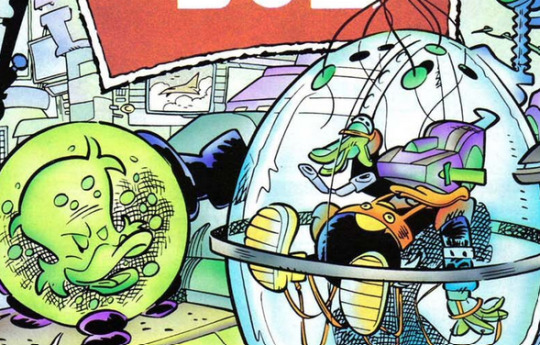
sick vr helmet donald has going on--i'd love for uno to put me in the neuron pod. sorry thats what im calling this thing because the wires kinda look like neuron. shoutout to the plane in the back
dhasam-bul. alright. can get behind yellow and pink those are colors i like despite spam being incredibly purple... oughgh the colors in duckburg are nice too sorry i just like how its pastel rainbow in this comic
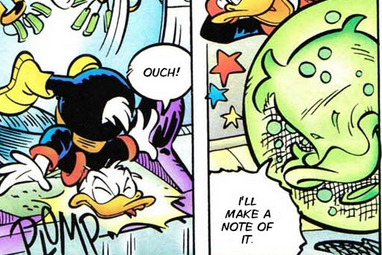
uno so silly... we need more uno laughing at donald's suffering i think

donald's stupid smug face i'm so mad. men to say Who's laughing now?
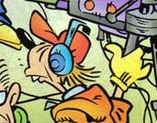
shoutout to this random camera guy in the background. ooh... if there's a hacker type situation. and there's vr. is donald gonna go in the computer PLEASE that was always my favorite like. trope as a kid. when they'd go inside a video game or the internet or something and you'd see all these dated 90s depictions of technology it was the best looking thing to me no matter the quality of the episode itself. yes lets go digital was my favorite episode of phin.eas and ferb
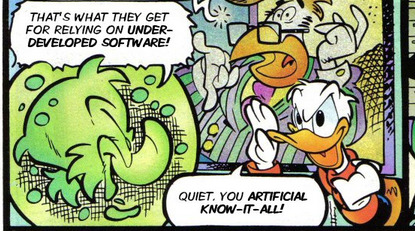
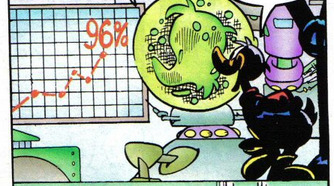
i love how uno's always so cheeky. and you know what. he deserves to look down on other computers. ough the uno donald expressions are always silly in these opening sections i'm so glad uno's around so often

yesssss.... i should have guessed this by the fact there were all sorts of ones and zeroes on the cover but oho. ohohoho...
i would screenshot these donald uno panels too but there's so many of them and they're all so cute on this page ough. the little cleanup robots uno sent out are cute. not like in a megavolt way but in a "that's cute looking" way sorry i have to specify now
JFIOEAJFOIAEJ UNO JUST DROPPING DONALD DOWN THE ELEVATOR im so

sorry uno smiling is always a must screenshot
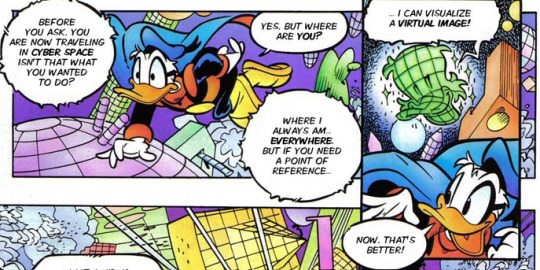
oughoughogugohgoghough now this is the SHIT i came here for! polygons. even like fake polygons. ohoho. oohhoohoo the clouds and the abstraction are a welcome addition but i like how he's swimming in it. yessssss
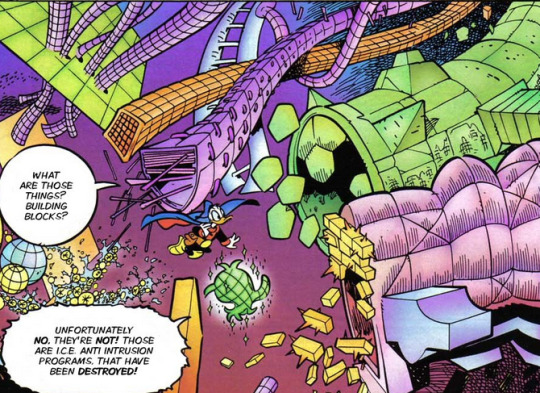
i don't know i'm just a sucker for this kind of like. abstraction view of the internet you know. its literally not how it works but damn it its so charming anyway. cyberspace...
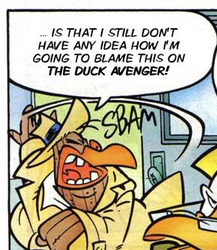
this shot of angus fangus is so goofy like with the dialogue and everything. whiny man

the bubbly little like. glitch effects. ooh. ooh. i like how he punishes donald for being just a little selfish
okay so That's where that's going. angus fangus is seeing a miku-like projection right now i see i see sorry. okay now the king kong is kinda sick i'll give them that. rigging projection lights...
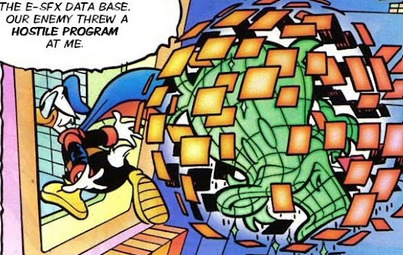
sorry im just laughing at all the goofy frames. like donald turning his back to uno suffering

i love the transition from serious donald to silly goofy donald. like all donald is silly goofy donald but paperinik just being like woof! i'm beat! after Deductioning is a treat to see okay
the cops harassing a guy just because he "looks foreign"? now that's the police!
donald likes going into cyberspace doesn't he...

i love how lying is bolded here. makes me think he's saying it like Lying! (jazz hands). the jazz hands are essential but he doesn't have hands so jazz... thoughts. programming. his processors are overloading!! his ram is getting too much information!! he's getting overstimulated!!

uno vocaloi.d when
i like how uno's first thought is uhhhhhh you see donald we could ummmmm toon.town online it! we could smash him, if i must proclaim, with hammers!
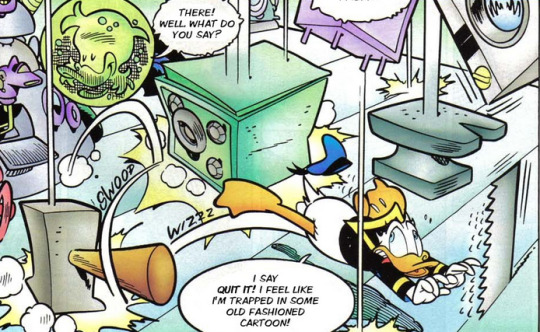
3d projector technology (at least for vo.caloid performances) literally us just like. using mutliple projectors with different things at different angles to produce one single image, so! i like how donald calls angus zuchini brain. reminded of bush brain and melon head...

this is my favorite person at the computer fair they slap

this panel slaps... sorry i just. pkna's hatching when used effectively sure is used effectively

:((((( god this plan is actually good like the dramatic irony here is spot on. donald can't tell why uno is stressed his expressions... the shattered uno orb.....................

ah i guess they are uno now. honestly bummer considering i thought they were going the other direction with it but considering this was bad enugh to make ducklair himeslf come back i should have probably seen this coming. and that he's two, uno with a triangle head. alright and he's already world dominating i miss uno
UNO!!! little stick ball uno... little guy's on backup now...


uno's face... HUFOEAHFE the way that he just SPROINGed away the electronic master key
this was a great issue! pkna does take a lot more to like. read than it does to engage with anything else but damn it. im a sucker for virtual crap and its always nice seeing a plethora of uno
7 notes
·
View notes
Text
Latest Trends and Developments in XMLTV EPG Technology
Exploring Innovations: The Latest Tools for Optimizing VR Development Platforms Emerging technologies and trends are reshaping the landscape of xml schedule epg guide propelling it towards more advanced, immersive, and interactive virtual reality applications. Cloud-based processing is now a cornerstone, enabling offloading of heavy computational tasks to the cloud, which results in high-quality…

View On WordPress
11 notes
·
View notes
Text
How-To IT
Topic: Core areas of IT
1. Hardware
• Computers (Desktops, Laptops, Workstations)
• Servers and Data Centers
• Networking Devices (Routers, Switches, Modems)
• Storage Devices (HDDs, SSDs, NAS)
• Peripheral Devices (Printers, Scanners, Monitors)
2. Software
• Operating Systems (Windows, Linux, macOS)
• Application Software (Office Suites, ERP, CRM)
• Development Software (IDEs, Code Libraries, APIs)
• Middleware (Integration Tools)
• Security Software (Antivirus, Firewalls, SIEM)
3. Networking and Telecommunications
• LAN/WAN Infrastructure
• Wireless Networking (Wi-Fi, 5G)
• VPNs (Virtual Private Networks)
• Communication Systems (VoIP, Email Servers)
• Internet Services
4. Data Management
• Databases (SQL, NoSQL)
• Data Warehousing
• Big Data Technologies (Hadoop, Spark)
• Backup and Recovery Systems
• Data Integration Tools
5. Cybersecurity
• Network Security
• Endpoint Protection
• Identity and Access Management (IAM)
• Threat Detection and Incident Response
• Encryption and Data Privacy
6. Software Development
• Front-End Development (UI/UX Design)
• Back-End Development
• DevOps and CI/CD Pipelines
• Mobile App Development
• Cloud-Native Development
7. Cloud Computing
• Infrastructure as a Service (IaaS)
• Platform as a Service (PaaS)
• Software as a Service (SaaS)
• Serverless Computing
• Cloud Storage and Management
8. IT Support and Services
• Help Desk Support
• IT Service Management (ITSM)
• System Administration
• Hardware and Software Troubleshooting
• End-User Training
9. Artificial Intelligence and Machine Learning
• AI Algorithms and Frameworks
• Natural Language Processing (NLP)
• Computer Vision
• Robotics
• Predictive Analytics
10. Business Intelligence and Analytics
• Reporting Tools (Tableau, Power BI)
• Data Visualization
• Business Analytics Platforms
• Predictive Modeling
11. Internet of Things (IoT)
• IoT Devices and Sensors
• IoT Platforms
• Edge Computing
• Smart Systems (Homes, Cities, Vehicles)
12. Enterprise Systems
• Enterprise Resource Planning (ERP)
• Customer Relationship Management (CRM)
• Human Resource Management Systems (HRMS)
• Supply Chain Management Systems
13. IT Governance and Compliance
• ITIL (Information Technology Infrastructure Library)
• COBIT (Control Objectives for Information Technologies)
• ISO/IEC Standards
• Regulatory Compliance (GDPR, HIPAA, SOX)
14. Emerging Technologies
• Blockchain
• Quantum Computing
• Augmented Reality (AR) and Virtual Reality (VR)
• 3D Printing
• Digital Twins
15. IT Project Management
• Agile, Scrum, and Kanban
• Waterfall Methodology
• Resource Allocation
• Risk Management
16. IT Infrastructure
• Data Centers
• Virtualization (VMware, Hyper-V)
• Disaster Recovery Planning
• Load Balancing
17. IT Education and Certifications
• Vendor Certifications (Microsoft, Cisco, AWS)
• Training and Development Programs
• Online Learning Platforms
18. IT Operations and Monitoring
• Performance Monitoring (APM, Network Monitoring)
• IT Asset Management
• Event and Incident Management
19. Software Testing
• Manual Testing: Human testers evaluate software by executing test cases without using automation tools.
• Automated Testing: Use of testing tools (e.g., Selenium, JUnit) to run automated scripts and check software behavior.
• Functional Testing: Validating that the software performs its intended functions.
• Non-Functional Testing: Assessing non-functional aspects such as performance, usability, and security.
• Unit Testing: Testing individual components or units of code for correctness.
• Integration Testing: Ensuring that different modules or systems work together as expected.
• System Testing: Verifying the complete software system’s behavior against requirements.
• Acceptance Testing: Conducting tests to confirm that the software meets business requirements (including UAT - User Acceptance Testing).
• Regression Testing: Ensuring that new changes or features do not negatively affect existing functionalities.
• Performance Testing: Testing software performance under various conditions (load, stress, scalability).
• Security Testing: Identifying vulnerabilities and assessing the software’s ability to protect data.
• Compatibility Testing: Ensuring the software works on different operating systems, browsers, or devices.
• Continuous Testing: Integrating testing into the development lifecycle to provide quick feedback and minimize bugs.
• Test Automation Frameworks: Tools and structures used to automate testing processes (e.g., TestNG, Appium).
19. VoIP (Voice over IP)
VoIP Protocols & Standards
• SIP (Session Initiation Protocol)
• H.323
• RTP (Real-Time Transport Protocol)
• MGCP (Media Gateway Control Protocol)
VoIP Hardware
• IP Phones (Desk Phones, Mobile Clients)
• VoIP Gateways
• Analog Telephone Adapters (ATAs)
• VoIP Servers
• Network Switches/ Routers for VoIP
VoIP Software
• Softphones (e.g., Zoiper, X-Lite)
• PBX (Private Branch Exchange) Systems
• VoIP Management Software
• Call Center Solutions (e.g., Asterisk, 3CX)
VoIP Network Infrastructure
• Quality of Service (QoS) Configuration
• VPNs (Virtual Private Networks) for VoIP
• VoIP Traffic Shaping & Bandwidth Management
• Firewall and Security Configurations for VoIP
• Network Monitoring & Optimization Tools
VoIP Security
• Encryption (SRTP, TLS)
• Authentication and Authorization
• Firewall & Intrusion Detection Systems
• VoIP Fraud DetectionVoIP Providers
• Hosted VoIP Services (e.g., RingCentral, Vonage)
• SIP Trunking Providers
• PBX Hosting & Managed Services
VoIP Quality and Testing
• Call Quality Monitoring
• Latency, Jitter, and Packet Loss Testing
• VoIP Performance Metrics and Reporting Tools
• User Acceptance Testing (UAT) for VoIP Systems
Integration with Other Systems
• CRM Integration (e.g., Salesforce with VoIP)
• Unified Communications (UC) Solutions
• Contact Center Integration
• Email, Chat, and Video Communication Integration
2 notes
·
View notes
Note
"It's okay, there's no time limit-- the score counter is just to get a sense of what you can do. It won't go on any permanent records or anything."
♫ Rex was holding a notepad and pen. He's also given Dreamy Cloud some VR goggles to simulate waypoints to fly through, and simple obstacles to navigate along the way. They were easily discernible from the environment because of their limited polygons*, just hovering in mid-air in wide open spaces. (*Just to be safe, Rex made sure nobody capable of making retro game/early computer 3D art style constructs with their superpowers were running around today either. None were found, hopefully none would show up last minute...)
He blew a whistle. Mostly for that gym coach effect. Otherwise Dreamy Cloud was free to start whenever.
"Umm...alright.."
Dreamy Cloud fidgeted with the strap of her VR goggles and tried not to look down. She was really starting to regret approaching Rex to coach her on the fine art of flight. No offense to Rex, of course. It had nothing to do with him and all to do with her fear of heights.
And it was a fear she had been thinking of overcoming.
Among the heroes of Bayfloat, none of them flew. Not currently, at least. Dreamy could levitate herself, in fact she often hovered slightly above the ground to keep with her cloud theme. She, however, could not fly. She simply had not learned to.
Learning how to fly would mean she could help out more. And possibly, it could give her an edge over the mechanical squadron and Coldsnap. Not that it was a competition or anything.
Rex blew the whistle and Dreamy Cloud flew off the ledge. Only for her to momentarily glance down. She froze. And then slowly hovered back to the ledge.
Oh this was going to be harder than she thought.
2 notes
·
View notes
Text
Bloom Your Ideas With The Latest App Development Trends

A mobile app is a software application designed specifically for small, wireless computing devices like smartphones and tablets, as opposed to desktop or laptop computers. Similarly, your company’s success can become a reality if it is supported by a mobile app development process that has been tested and refined over time. Numerous companies offer the best App Development Agency in New York, Think United Services Company is one of these. Our mobile development process comprises six stages: strategy, analysis and planning, design, app development, testing, and deployment. Therefore, our mobile app development company in Nassau County, NY, aims to create iOS and Android applications that effectively increase your business revenue and leads. Moreover, you must describe your business app concept to our development team. They will explain to you the best solutions that are cost-effective and result oriented.
thinkunitedservices.com As previously said, each software has different purchasing and features. The mobile app development industry is constantly changing; therefore, technological advancements, consumer demands, and various other factors directly influence mobile app trends. Currently, the thinkunitedservices.com website serves you with the latest app development services in New York at reasonable prices. However, moving on with the latest trends is arguably essential to success in this industry. Similarly, designing an app aims to maximize productivity and revenue while requiring a minor investment. Aside from that, specific skills are needed to develop, maintain, and design a web app. Think United Services agency is here to overcome the fear of responsive apps. We are the best app development company in Nassau County, NY. Now, let’s discuss the trends of the latest app development as below- IoT app integration (Internet of Things) 5G technology approach App development for wearable and foldable devices Beacon technology Mobile E-commerce revenue Use of AI (Artificial Intelligence) Mobile transactions and wallets AR (Augmented Reality) and Computer Simulation (Virtual reality) Chatbots High Caliber security or Two-factor authentication Cloud Computing integration Instant and on-demand apps Futuristic goals of app development According to a Statista report from the second quarter of 2021, users downloaded approximately 28 billion apps from the Google Play Store and about 7.9 million from the App Store. Furthermore, by the end of 2022, US consumers will spend $34 billion or more on apps through app stores. This year’s hottest mobile app development trends are augmented reality (AR) and virtual reality (VR). At the same time, Statista predicts that the global AR and VR market will reach $296.9 billion US dollars in 2024, and this significant increase in demand is for a good reason in the app development field. So, to meet all your needs for top-notch app development services in New York, they are completed at the thinkunitedservices.com website. In addition, we have a professional team for app services and offer inexpensive packages for all your requirements with result-oriented services. Brief In brief, Think United Services Company is the best agency for getting quality-assured app development services in New York. Likewise, you can also contact us for the latest digital marketing assistance and more.
Source: https://thinkunitedservices.com/bloom-your-ideas-with-the-latest-app-development-trends/
#thinkunitedservices#webdesigning#smo#seo#ppc#digital marketing company in usa#itservicescmpany#appdevelopmentnewyork
5 notes
·
View notes